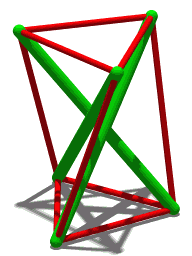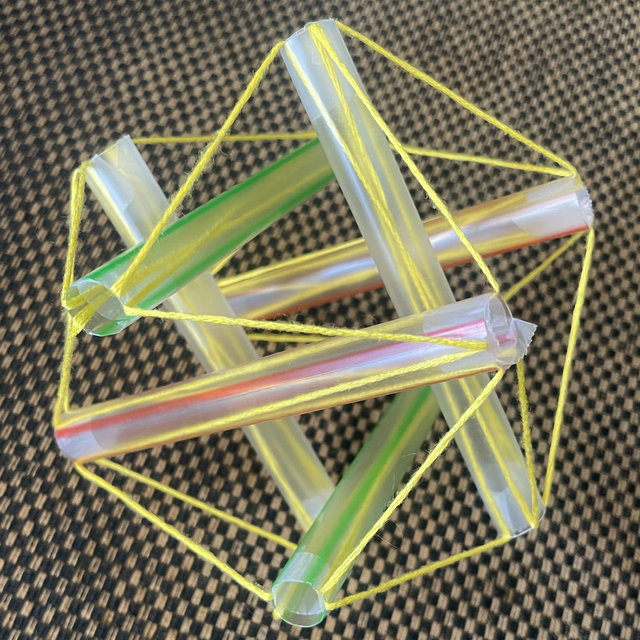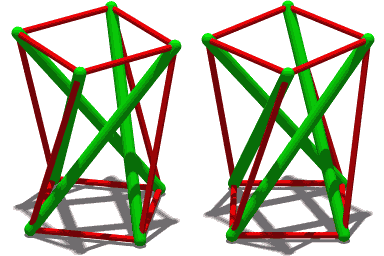Top Qs
Timeline
Chat
Perspective
Tensegrity
Structural design made of isolated members held in place by tension From Wikipedia, the free encyclopedia
Remove ads
Tensegrity, tensional integrity or floating compression is a structural principle based on a system of isolated components under compression inside a network of continuous tension, and arranged in such a way that the compressed members (usually bars or struts) do not touch each other while the prestressed tensioned members (usually cables or tendons) delineate the system spatially.[1]

Tensegrity structures are found in both nature and human-made objects: in the human body, the bones are held in compression while the connective tissues are held in tension, and the same principles have been applied to furniture and architectural design and beyond.
The term was coined by Buckminster Fuller in the 1960s as a portmanteau of "tensional integrity".[2]
Remove ads
Core concept
Summarize
Perspective
Tensegrity is characterized by several foundational principles that define its unique properties:
- Continuous tension: Fundamental to tensegrity, the tension elements—typically cables or tendons—form a continuous network that encases the entire structure. This allows for the even distribution of mechanical stresses and maintains the structural form, contributing to the overall stability and flexibility of the system.
- Discontinuous compression: The compression components, such as struts or rods, are distinct in that they do not make direct contact with each other but are instead suspended within the tension network. This eliminates the need for rigid connections, enhancing the structural efficiency and resilience of the system.
- Pre-stressed: A key aspect of tensegrity structures is their pre-stressed state, in which tension elements are tightened during the assembly process. Pre-stressing contributes significantly to the structural stiffness and stability, ensuring that all elements are either in tension or compression at all times.
- Self-equilibration: Tensegrity structures are self-equilibrating and so automatically distribute internal stresses across the structure. This allows them to adapt to varying loads without losing structural integrity.
- Minimalism and efficiency: Tensegrity systems employ a minimalist design philosophy, utilizing the minimum amount of materials to achieve maximum structural strength.
- Scalability and modularity: The design principles of tensegrity allow for scalability and modular construction. Tensegrity structures to be easily adapted or expanded in size and complexity according to specific requirements.
Because of these patterns, no structural member experiences a bending moment and there are no shear stresses within the system. This can produce exceptionally strong and rigid structures for their mass and for the cross section of the components.
These principles collectively enable tensegrity structures to achieve a balance of strength, resilience, and flexibility, making the concept widely applicable across disciplines including architecture, robotics, and biomechanics.
Remove ads
Early example

A conceptual building block of tensegrity is seen in the 1951 Skylon. Six cables, three at each end, hold the tower in position. The three cables connected to the bottom "define" its location. The other three cables are simply keeping it vertical.
A three-rod tensegrity structure (shown above in a spinning drawing of a T3-Prism) builds on this simpler structure: the ends of each green rod look like the top and bottom of the Skylon. As long as the angle between any two cables is smaller than 180°, the position of the rod is well defined. While three cables are the minimum required for stability, additional cables can be attached to each node for aesthetic purposes and for redundancy. For example, Kenneth Snelson's Needle Tower uses a repeated pattern built using nodes that are connected to 5 cables each.
Eleanor Heartney points out visual transparency as an important aesthetic quality of these structures.[3] Korkmaz et al. has argued that lightweight tensegrity structures are suitable for adaptive architecture.[4][5]
Remove ads
Applications
Summarize
Perspective
Architecture
Tensegrities saw increased application in architecture beginning in the 1960s, when Maciej Gintowt and Maciej Krasiński designed Spodek arena complex (in Katowice, Poland), as one of the first major structures to employ the principle of tensegrity. The roof uses an inclined surface held in check by a system of cables holding up its circumference. Tensegrity principles were also used in David Geiger's Seoul Olympic Gymnastics Arena (for the 1988 Summer Olympics), and the Georgia Dome (for the 1996 Summer Olympics). Tropicana Field, home of the Tampa Bay Rays major league baseball team, also has a dome roof supported by a large tensegrity structure.

On 4 October 2009, the Kurilpa Bridge opened across the Brisbane River in Queensland, Australia. A multiple-mast, cable-stay structure based on the principles of tensegrity, it is currently the world's largest tensegrity bridge.
Robotics

Since the early 2000s, tensegrities have also attracted the interest of roboticists due to their potential to design lightweight and resilient robots. Numerous researches have investigated tensegrity rovers,[6] bio-mimicking robots,[7][8][9] and modular soft robots.[10] The most famous tensegrity robot is the Super Ball Bot,[11] a rover for space exploration using a 6-bar tensegrity structure, currently under developments at NASA Ames.
Anatomy
Biotensegrity, a term coined by Stephen Levin, is an extended theoretical application of tensegrity principles to biological structures.[12] Biological structures such as muscles, bones, fascia, ligaments and tendons, or rigid and elastic cell membranes, are made strong by the unison of tensioned and compressed parts. The musculoskeletal system consists of a continuous network of muscles and connective tissues,[13] while the bones provide discontinuous compressive support, whilst the nervous system maintains tension in vivo through electrical stimulus. Levin claims that the human spine, is also a tensegrity structure although there is no support for this theory from a structural perspective.[14]
Biochemistry
Donald E. Ingber has developed a theory of tensegrity to describe numerous phenomena observed in molecular biology.[15] For instance, the expressed shapes of cells, whether it be their reactions to applied pressure, interactions with substrates, etc., all can be mathematically modelled by representing the cell's cytoskeleton as a tensegrity. Furthermore, geometric patterns found throughout nature (the helix of DNA, the geodesic dome of a volvox, Buckminsterfullerene, and more) may also be understood based on applying the principles of tensegrity to the spontaneous self-assembly of compounds, proteins,[16] and even organs. This view is supported by how the tension-compression interactions of tensegrity minimize material needed to maintain stability and achieve structural resiliency, although the comparison with inert materials within a biological framework has no widely accepted premise within physiological science.[17] Therefore, natural selection pressures would likely favor biological systems organized in a tensegrity manner.
As Ingber explains:
The tension-bearing members in these structures – whether Fuller's domes or Snelson's sculptures – map out the shortest paths between adjacent members (and are therefore, by definition, arranged geodesically). Tensional forces naturally transmit themselves over the shortest distance between two points, so the members of a tensegrity structure are precisely positioned to best withstand stress. For this reason, tensegrity structures offer a maximum amount of strength.[15]
In embryology, Richard Gordon proposed that embryonic differentiation waves are propagated by an 'organelle of differentiation'[18] where the cytoskeleton is assembled in a bistable tensegrity structure at the apical end of cells called the 'cell state splitter'.[19]
Remove ads
Origins and art history
Summarize
Perspective

The origins of tensegrity are not universally agreed upon.[21] Many traditional structures, such as skin-on-frame kayaks and shōji, use tension and compression elements in a similar fashion.
Russian artist Viatcheslav Koleichuk claimed that the idea of tensegrity was invented first by Kārlis Johansons (in Russian as German as Karl Ioganson) (lv), a Soviet avant-garde artist of Latvian descent, who contributed some works to the main exhibition of Russian constructivism in 1921.[22] Koleichuk's claim was backed up by Maria Gough for one of the works at the 1921 constructivist exhibition.[23] Snelson has acknowledged the constructivists as an influence for his work (query?).[24] French engineer David Georges Emmerich has also noted how Kārlis Johansons's work (and industrial design ideas) seemed to foresee tensegrity concepts.[25]
In fact, some scientific paper proves this fact, showing the images of the first Simplex structures (made with 3 bars and 9 tendons) developed by Ioganson.[26]
In 1948, artist Kenneth Snelson produced his innovative "X-Piece" after artistic explorations at Black Mountain College (where Buckminster Fuller was lecturing) and elsewhere. Some years later, the term "tensegrity" was coined by Fuller, who is best known for his geodesic domes. Throughout his career, Fuller had experimented with incorporating tensile components in his work, such as in the framing of his dymaxion houses.[27]
Snelson's 1948 innovation spurred Fuller to immediately commission a mast from Snelson. In 1949, Fuller developed a tensegrity-icosahedron based on the technology, and he and his students quickly developed further structures and applied the technology to building domes. After a hiatus, Snelson also went on to produce a plethora of sculptures based on tensegrity concepts. His main body of work began in 1959 when a pivotal exhibition at the Museum of Modern Art took place. At the MOMA exhibition, Fuller had shown the mast and some of his other work.[28] At this exhibition, Snelson, after a discussion with Fuller and the exhibition organizers regarding credit for the mast, also displayed some work in a vitrine.[29]
Snelson's best-known piece is his 26.5-meter-high (87-foot) Needle Tower of 1968.[30]
Remove ads
Mathematics of tensegrity
Summarize
Perspective
The loading of at least some tensegrity structures causes an auxetic response and negative Poisson ratio, e.g. the T3-prism and 6-strut tensegrity icosahedron.
Tensegrity prisms
The three-rod tensegrity structure (3-way prism) has the property that, for a given (common) length of compression member "rod" (there are three total) and a given (common) length of tension cable "tendon" (six total) connecting the rod ends together, there is a particular value for the (common) length of the tendon connecting the rod tops with the neighboring rod bottoms that causes the structure to hold a stable shape. For such a structure, it is straightforward to prove that the triangle formed by the rod tops and that formed by the rod bottoms are rotated with respect to each other by an angle of 5π/6 (radians).[31]
The stability ("prestressability") of several 2-stage tensegrity structures are analyzed by Sultan, et al.[32]
The T3-prism (also known as Triplex) can be obtained through form finding of a straight triangular prism. Its self-equilibrium state is given when the base triangles are in parallel planes separated by an angle of twist of π/6. The formula for its unique self-stress state is given by,[33]Here, the first three negative values correspond to the inner components in compression, while the rest correspond to the cables in tension.
Tensegrity icosahedra



The tensegrity icosahedron, first studied by Snelson in 1949,[34] has struts and tendons along the edges of a polyhedron called Jessen's icosahedron. It is a stable construction, albeit with infinitesimal mobility.[35][36] To see this, consider a cube of side length 2d, centered at the origin. Place a strut of length 2l in the plane of each cube face, such that each strut is parallel to one edge of the face and is centered on the face. Moreover, each strut should be parallel to the strut on the opposite face of the cube, but orthogonal to all other struts. If the Cartesian coordinates of one strut are and , those of its parallel strut will be, respectively, and . The coordinates of the other strut ends (vertices) are obtained by permuting the coordinates, e.g., (rotational symmetry in the main diagonal of the cube).
The distance s between any two neighboring vertices (0, d, l) and (d, l, 0) is
Imagine this figure built from struts of given length 2l and tendons (connecting neighboring vertices) of given length s, with . The relation tells us there are two possible values for d: one realized by pushing the struts together, the other by pulling them apart. In the particular case the two extremes coincide, and , therefore the figure is the stable tensegrity icosahedron. This choice of parameters gives the vertices the positions of Jessen's icosahedron; they are different from the regular icosahedron, for which the ratio of and would be the golden ratio, rather than 2. However both sets of coordinates lie along a continuous family of positions ranging from the cuboctahedron to the octahedron (as limit cases), which are linked by a helical contractive/expansive transformation. This kinematics of the cuboctahedron is the geometry of motion of the tensegrity icosahedron. It was first described by H. S. M. Coxeter[37] and later called the "jitterbug transformation" by Buckminster Fuller.[38][39]
Since the tensegrity icosahedron represents an extremal point of the above relation, it has infinitesimal mobility: a small change in the length s of the tendon (e.g. by stretching the tendons) results in a much larger change of the distance 2d of the struts.[40]
Remove ads
Patents
- U.S. patent 3,063,521, "Tensile-Integrity Structures," 13 November 1962, Buckminster Fuller.
- French Patent No. 1,377,290, "Construction de Reseaux Autotendants", 28 September 1964, David Georges Emmerich.
- French Patent No. 1,377,291, "Structures Linéaires Autotendants", 28 September 1964, David Georges Emmerich.
- U.S. patent 3,139,957, "Suspension Building" (also called aspension), 7 July 1964, Buckminster Fuller.
- U.S. patent 3,169,611, "Continuous Tension, Discontinuous Compression Structure," 16 February 1965, Kenneth Snelson.
- U.S. patent 3,866,366, "Non-symmetrical Tension-Integrity Structures," 18 February 1975, Buckminster Fuller.
Remove ads
Basic tensegrity structures
- The simplest tensegrity structure, a 3-prism
- Another 3-prism
- A similar structure but with four compression members
- Proto-Tensegrity Prism by Karl Ioganson, 1921[gallery 1]
- Tensegrity Icosahedron, Buckminster Fuller, 1949[gallery 2]
- Tensegrity Tetrahedron, Francesco della Salla, 1952[gallery 3]
- Tensegrity X-Module Tetrahedron, Kenneth Snelson, 1959[gallery 4]
Tensegrity structures
- Kenneth Snelson's Needle Tower art sculpture.
- A tensegrity dome made of garden stakes and nylon twine built in the yard of a house, 2009
- A 12m high tensegrity structure exhibit at the Science City, Kolkata.
- Dissipate, an hourglass tower art sculpture including tensegrity structure, constructed at AfrikaBurn, 2015, a Burning Man regional event
In chemistry
Sometimes highly strained molecules can be surprisingly stable due to lack of easily accessible decomposition pathways, like cubane or 1.1.1-propellane.
See also
- Cloud Nine – Proposed airborne habitats, giant sky-floating tensegrity spheres named by Buckminster Fuller
- Hyperboloid structure – Type of unbounded quadratic surface-shaped building or work
- Interactions of actors theory
- Saddle roof
- Space frame – Rigid three-dimensional load-bearing truss structure
- Synergetics – Empirical study of systems in transformation
- Tensairity
- Tensile structure – Structure whose members are only in tension
- Thin-shell structure – Thin-walled geometric solid
- Kinematics of the cuboctahedron – Symmetrical transformations of the cuboctahedron into related uniform polyhedra, the geometry of the motion of the tensegrity icosahedron
Remove ads
Notes
- Gómez-Jáuregui 2010, p. 28. Fig. 2.1
- Fuller & Marks 1960, Fig. 270
- Fuller & Marks 1960, Fig. 268.
- Lalvani 1996, p. 47
References
Bibliography
Further reading
External links
Wikiwand - on
Seamless Wikipedia browsing. On steroids.
Remove ads


![{\displaystyle \omega =\omega _{1}[-{\sqrt {3}},-{\sqrt {3}},-{\sqrt {3}},{\sqrt {3}},{\sqrt {3}},{\sqrt {3}},1,1,1,1,1,1]^{T}}](http://wikimedia.org/api/rest_v1/media/math/render/svg/cdf881ba88de87799c28d2fcb13c5b26fe0febf2)





















